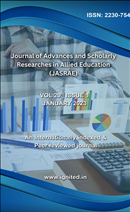Role of Aarogya Setu Application to Machine Learning Approach on Covid-19
Keywords:
Machine Learning Approach, Aarogya Setu, Ensemble learning, Covid-19Abstract
The paper deals with “Role of Aarogya Setu Application to Machine Learning Approach on Covid-19.” A random sample 250 male groups of the age range 25-40 and 41-65 years age has been selected from Ministry of India & Arogya Setu application. The different age groups 25-40 and 41-65 years old do not differ in terms of Aarogya Setu application. shows that 25-40 and 41-65 years age groups do not differ in terms of Aarogya Setu application. The age groups of 25-40 has been found 95.20% awareness and 41-65 years age groups was found 75.20 on Aarogya Setu application and creating awareness of various causes impacts on Covid-19.
Downloads
References
REFERENCE
Masum, A. K. M., Khushbu, S. A., Keya, M., Abujar, S., & Hossain, S. A. (2020). COVID-19 in Bangladesh: a deeper outlook into the forecast with prediction of upcoming per day cases using time series. Procedia Computer Science, 178, 291-300.
Alamo, T., Reina, D. G., Mammarella, M., & Abella, A. (2020). Covid-19: Open-data resources for monitoring, modeling, and forecasting the epidemic. Electronics, 9(5), 827.
Alimadadi, A., Aryal, S., Manandhar, I., Munroe, P. B., Joe, B., & Cheng, X. (2020). Artificial intelligence and machine learning to fight COVID-19. Physiological genomics, 52(4), 200-202.
Al-Qaness, M. A., Ewees, A. A., Fan, H., & Abd El Aziz, M. (2020). Optimization method for forecasting confirmed cases of COVID-19 in China. Journal of Clinical Medicine, 9(3), 674.
Ardabili, S. F., Mosavi, A., Ghamisi, P., Ferdinand, F., Varkonyi-Koczy, A. R., Reuter, U., & Atkinson, P. M. (2020). Covid-19 outbreak prediction with machine learning. Algorithms, 13(10), 249.
Azarafza, M., Azarafza, M., & Tanha, J. (2020). COVID-19 infection forecasting based on deep learning in Iran, medRxiv.
Baldé, M. A. (2020). Fitting SIR model to COVID-19 pandemic data and comparative forecasting with machine learning. medRxiv.
Car, Z., Baressi Šegota, S., Andelić, N., Lorencin, I., & Mrzljak, V. (2020). Modeling the spread of COVID-19 infection using a multilayer perceptron. Computational and mathematical methods in medicine, 2020.
Dandekar, R., & Barbastathis, G. (2020). Quantifying the effect of quarantine control in Covid19 infectious spread using machine learning, medRxiv.
Iwendi, C., Bashir, A. K., Peshkar, A., Sujatha, R., Chatterjee, J. M., Pasupuleti, S., ... & Jo, O. (2020). COVID-19 patient health prediction using boosted random forest algorithm. Frontiers in public health, 8, 357.
Khan, S., Bashir, A. K., Iwendi, C., Gadekallu, T. R., & Deepa, N. (2020). A feature extraction based approach to detect Covid-19 related fake news. Appl Soft Comput.
Huang, C. J., Chen, Y. H., Ma, Y., & Kuo, P. H. (2020). Multiple-input deep convolutional neural network model for covid-19 forecasting in china. MedRxiv.











